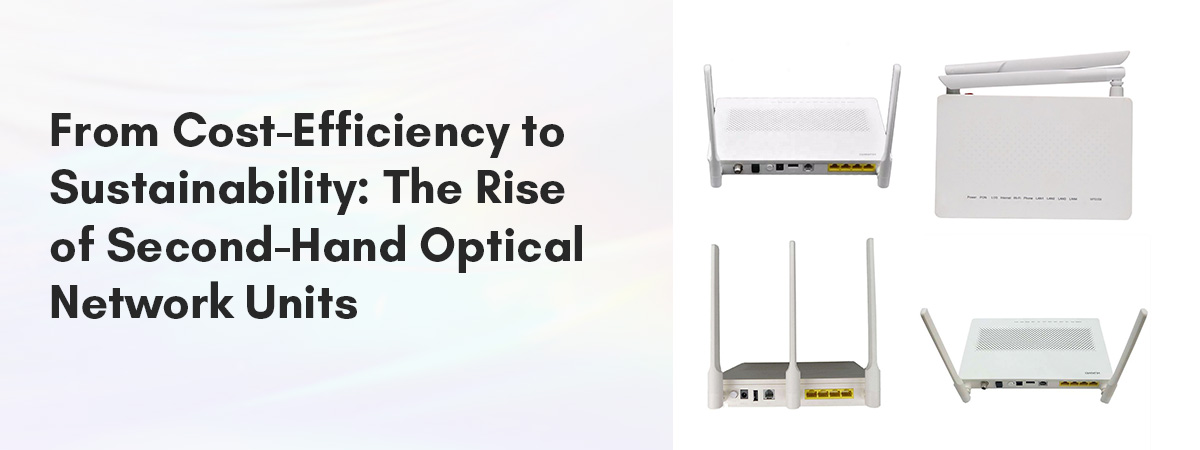In the ever-evolving landscape of networking technology, the allure of second-hand Optical Network Units (ONU) is undeniable. As the digital infrastructure expands globally, the demand for reliable and cost-effective networking solutions has surged, propelling the popularity of refurbished ONUs. In this comprehensive guide, we delve into the reasons behind their popularity, highlight regions where they are in high demand, discuss key considerations when purchasing used ONUs, and showcase some trendy models dominating the market. Furthermore, we’ll explore the advantages and disadvantages of these trendy models to provide a holistic view for potential buyers.
The Appeal of Second-Hand ONUs:
Cost-Efficiency:
One of the primary reasons behind the popularity of second-hand ONUs is their cost-effectiveness. For businesses and individuals seeking to expand their network infrastructure without breaking the bank, refurbished units offer a budget-friendly alternative. By opting for used ONUs, organizations can allocate their resources more efficiently, redirecting savings towards other critical aspects of their operations.
Environmental Sustainability:
In an era marked by growing environmental consciousness, the refurbishment and reuse of electronic devices have gained significant traction. Second-hand ONUs contribute to the circular economy by extending the lifespan of networking equipment and reducing electronic waste. By choosing refurbished units, businesses actively participate in sustainable practices, minimizing their ecological footprint while reaping the benefits of reliable networking solutions.
Accessibility to Advanced Technology:
The rapid pace of technological innovation often renders recent models obsolete within a short span. However, many refurbished ONUs still offer robust performance and functionality comparable to newer counterparts. For organizations aiming to leverage advanced networking capabilities without incurring exorbitant costs, second-hand ONUs present an attractive proposition, enabling access to cutting-edge technology at a fraction of the price.
Regions Fostering Second-Hand ONU Adoption:
Emerging Markets:
Emerging economies, characterized by burgeoning digital infrastructure requirements and budget constraints, represent a significant market for second-hand ONUs. Countries across Asia, Africa, and Latin America exhibit a growing demand for affordable networking solutions to support their expanding telecommunications networks. In regions where infrastructure development outpaces disposable income, refurbished ONUs emerge as a pragmatic choice, facilitating connectivity without compromising quality.
Small and Medium Enterprises (SMEs):
Small and medium enterprises often operate within tight budget constraints, making cost-effective networking solutions essential for sustaining their operations. In regions with a high concentration of SMEs, such as Southeast Asia and Eastern Europe, the demand for second-hand ONUs is particularly pronounced. These businesses prioritize affordability and reliability, making refurbished units an ideal fit for their networking needs.
Things to Consider When Purchasing Used ONU:
Supplier Reputation:
When sourcing second-hand ONUs, it’s crucial to partner with reputable suppliers known for their quality products and reliable service. Conduct thorough research and seek recommendations from trusted sources to ensure that the supplier adheres to stringent refurbishment standards and offers warranties or guarantees for their products.
Compatibility and Scalability:
Before making a purchase, assess the compatibility of the refurbished ONU with your existing network infrastructure. Ensure that the unit supports the required protocols and interfaces to seamlessly integrate into your network environment. Additionally, consider the scalability of the ONU to accommodate future expansion requirements, mitigating the risk of premature obsolescence.
Quality Assurance:
Insist on thorough testing and quality assurance processes to verify the performance and reliability of the refurbished ONU. Look for certifications or compliance with industry standards to ascertain the unit’s adherence to quality benchmarks. Transparent documentation detailing the refurbishment process and any refurbishment warranties further instill confidence in the product’s reliability.
Trendy Models in the Second-Hand ONU Market:
Now, let’s delve into the advantages and disadvantages of the trendy models dominating the second-hand ONU market:
1. HG6821M:
- Advantages:
- High-speed connectivity suitable for demanding applications.
- Advanced security features for enhanced network protection.
- Disadvantages:
- May have limited compatibility with certain network configurations.
- Higher power consumption compared to some other models.
2. GS3101:
- Advantages:
- Compact design ideal for space-constrained environments.
- Seamless integration with existing network infrastructure.
- Disadvantages:
- Limited scalability for large-scale network deployments.
- May lack some advanced features present in newer models.
3. HG6543C:
- Advantages:
- Robust performance for reliable data transmission.
- Versatile connectivity options to accommodate diverse networking needs.
- Disadvantages:
- Higher upfront cost compared to entry-level models.
- May require additional configuration for optimal performance.
4. F460:
- Advantages:
- Flexible deployment options for various network architectures.
- Enhanced management capabilities for streamlined network administration.
- Disadvantages:
- Limited availability in certain regions, impacting procurement options.
- Potential compatibility issues with non-standard network setups.
5. GM220:
- Advantages:
- High throughput for rapid data transfer in bandwidth-intensive applications.
- Built-in redundancy features for increased reliability.
- Disadvantages:
- Higher initial investment compared to budget-friendly alternatives.
- Requires expertise for optimal configuration and management.
6. F663nv3a:
- Advantages:
- Comprehensive feature set catering to diverse networking requirements.
- Robust security protocols to safeguard against cyber threats.
- Disadvantages:
- Complex setup process may require specialized knowledge.
- Limited availability in the second-hand market may affect procurement options.
7. F450:
- Advantages:
- Economical solution for small-scale network deployments.
- User-friendly interface for simplified configuration and management.
- Disadvantages:
- Lower performance compared to high-end models.
- Limited scalability for future expansion needs.
In conclusion, while each trendy model offers unique advantages and disadvantages, the suitability of a second-hand ONU ultimately depends on specific network requirements, budget constraints, and deployment considerations. By carefully evaluating these factors and conducting thorough due diligence, businesses can make informed decisions when purchasing refurbished ONUs, maximizing the value and efficiency of their networking infrastructure. Embracing the refurbishment trend not only unlocks substantial cost savings but also contributes to the collective effort towards a more sustainable and interconnected digital future.
